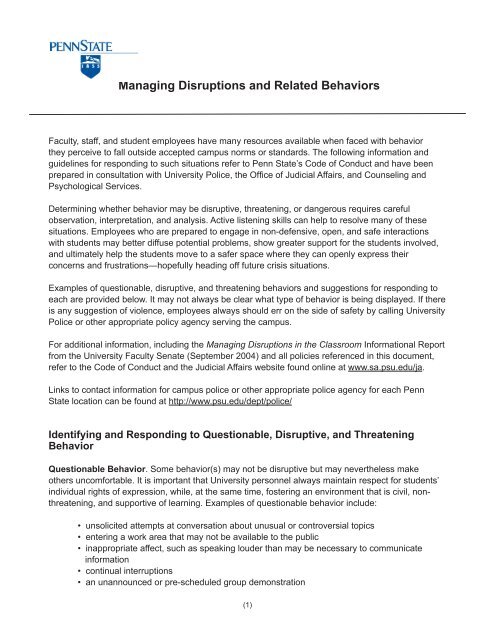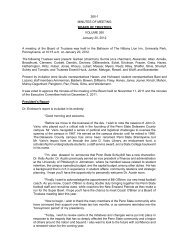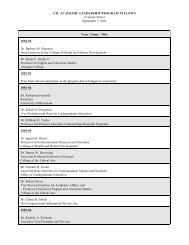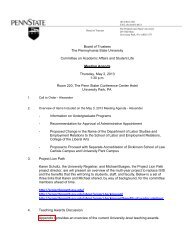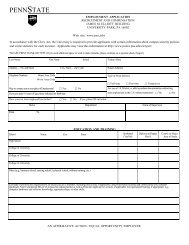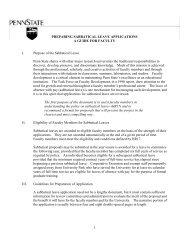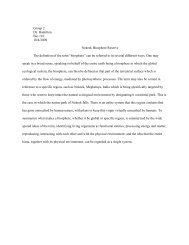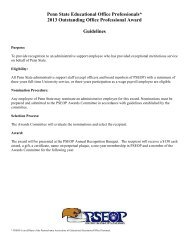Managing Disruptive Behavior - Penn State University
Managing Disruptive Behavior - Penn State University
Managing Disruptive Behavior - Penn State University
Create successful ePaper yourself
Turn your PDF publications into a flip-book with our unique Google optimized e-Paper software.
<strong>Managing</strong> Disruptions and Related <strong>Behavior</strong>s<br />
Faculty, staff, and student employees have many resources available when faced with behavior<br />
they perceive to fall outside accepted campus norms or standards. The following information and<br />
guidelines for responding to such situations refer to <strong>Penn</strong> <strong>State</strong>’s Code of Conduct and have been<br />
prepared in consultation with <strong>University</strong> Police, the Office of Judicial Affairs, and Counseling and<br />
Psychological Services.<br />
Determining whether behavior may be disruptive, threatening, or dangerous requires careful<br />
observation, interpretation, and analysis. Active listening skills can help to resolve many of these<br />
situations. Employees who are prepared to engage in non-defensive, open, and safe interactions<br />
with students may better diffuse potential problems, show greater support for the students involved,<br />
and ultimately help the students move to a safer space where they can openly express their<br />
concerns and frustrations—hopefully heading off future crisis situations.<br />
Examples of questionable, disruptive, and threatening behaviors and suggestions for responding to<br />
each are provided below. It may not always be clear what type of behavior is being displayed. If there<br />
is any suggestion of violence, employees always should err on the side of safety by calling <strong>University</strong><br />
Police or other appropriate policy agency serving the campus.<br />
For additional information, including the <strong>Managing</strong> Disruptions in the Classroom Informational Report<br />
from the <strong>University</strong> Faculty Senate (September 2004) and all policies referenced in this document,<br />
refer to the Code of Conduct and the Judicial Affairs website found online at www.sa.psu.edu/ja.<br />
Links to contact information for campus police or other appropriate police agency for each <strong>Penn</strong><br />
<strong>State</strong> location can be found at http://www.psu.edu/dept/police/<br />
Identifying and Responding to Questionable, <strong>Disruptive</strong>, and Threatening<br />
<strong>Behavior</strong><br />
Questionable <strong>Behavior</strong>. Some behavior(s) may not be disruptive but may nevertheless make<br />
others uncomfortable. It is important that <strong>University</strong> personnel always maintain respect for students’<br />
individual rights of expression, while, at the same time, fostering an environment that is civil, nonthreatening,<br />
and supportive of learning. Examples of questionable behavior include:<br />
• unsolicited attempts at conversation about unusual or controversial topics<br />
• entering a work area that may not be available to the public<br />
• inappropriate affect, such as speaking louder than may be necessary to communicate<br />
information<br />
• continual interruptions<br />
• an unannounced or pre-scheduled group demonstration<br />
(1)
If these types of behavior are having a negative impact, the employee initially should request<br />
that the behavior cease or be modified. Only in those cases when a person refuses to respond<br />
and his/her behavior becomes further disruptive would additional action be appropriate.<br />
<strong>Disruptive</strong> <strong>Behavior</strong>. When a person’s behavior results in some disruption of the workplace/<br />
community, additional steps may be necessary in response. <strong>Penn</strong> <strong>State</strong>’s Code of Conduct<br />
defines disruption as “. . . an action or combination of actions by one or more individuals that<br />
unreasonably interferes with, hinders, obstructs, or prevents the operation of the <strong>University</strong> or<br />
infringes on the rights of others to freely participate in its programs and services.” <strong>University</strong><br />
Code of Conduct, 2007.<br />
When assessing whether or not behavior is disruptive, the immediate and practical<br />
consequences of the conduct should be considered as well as whether it interferes with unit<br />
or academic operations or prevents others from participating fully in those activities. <strong>Disruptive</strong><br />
behavior should be confronted quickly and calmly by an employee. In most cases, simply<br />
making individuals aware of their behavior will resolve the situation. (Note: student workers may<br />
be reluctant to confront peers; however, they should be expected to confront disruptive behavior<br />
in the absence of full-time staff.)<br />
When behavior is determined to be disruptive, if appropriate and possible, a conversation<br />
should be initiated with the person in a private area unless there are safety concerns. When<br />
responding to disruptive conduct, the employee should:<br />
• speak calmly and explain to the person the behavior viewed as disruptive and/or<br />
interfering with the learning process (or in some cases, posing a risk to <strong>University</strong><br />
personnel and/or facilities), and ask them to stop<br />
• focus on behavior, not individuals or traits, and avoid personal accusations and threats<br />
• if necessary, explain that others, such as a supervisor or the police, may be informed,<br />
making clear that this possibility is being noted for the person’s consideration and<br />
that behavior will determine the course of action<br />
• listen to what the person is saying and acknowledge any concerns she or he may<br />
raise<br />
• when possible, suggest options to resolve the situation without further disruption or<br />
formal action (stay within own expertise)<br />
• look for others to assist if uncomfortable confronting behaviors alone<br />
• consider contacting <strong>University</strong> Police or the appropriate police agency serving the<br />
campus if the behavior persists and the disruptive person refuses to cooperate with<br />
clearly stated requests<br />
If the disruptive person is a student and the behavior is not considered threatening, the employee<br />
may explain to the student that a report will be submitted to the unit supervisor who may<br />
also wish to involve the Office of Judicial Affairs. Faculty have the authority to request a disruptive<br />
student to leave class but not to expel or force a student to drop a class on a temporary<br />
or permanent basis; this can only be done through the Office of Judicial Affairs. If the student<br />
becomes combative or the behavior escalates, the police should be called.<br />
(2)
Threatening <strong>Behavior</strong>. <strong>Behavior</strong> is considered threatening if it suggests the possibility of violence<br />
and physical harm. Immediate attention to safety is the priority and employees should first assess<br />
their own level of safety. If it is felt that it is appropriate to stay with the threatening person, the<br />
employee should remain in an open area with visible means of escape or enlist the help of another.<br />
There may be situations deemed safe enough to ask for the behavior to cease before calling the<br />
police (e.g., some departments have established a “code blue” system that alerts others in the area<br />
or in another office to offer immediate support). If the employee confronting the behavior or other<br />
employees in the office/unit feel threatened in any way, the police should be called. Examples of<br />
threatening behavior include, but are not limited to:<br />
• mention of a weapon<br />
• verbal comments which mention the desire to harm self or others<br />
• unwanted physical contact<br />
• comments referencing previous dangerous actions in which the person was involved<br />
• highly agitated or unpredictable behavior<br />
• aggression or violence<br />
Aggression and violence will vary from verbal or physical threats to verbal and physical abuse. It is<br />
very difficult to predict aggression and violence; however, some indicators of potential violence may<br />
include:<br />
• anger problems including violent fantasies (e.g. contents of writings, drawings)<br />
• fascination with weapons, accoutrements, and cruelty<br />
• loner or very withdrawn behaviors<br />
• suicidal/homicidal ideation and victim/martyr self concept expressed<br />
• stalking behaviors<br />
• non-compliance and disciplinary problems<br />
• interest in previous shooting situations<br />
• unusual and aberrant behavior<br />
• history with law enforcement<br />
• mental health history related to dangerousness including paranoia<br />
If an employee feels threatened or a situation escalates, the employee should remove him or herself<br />
from the situation and if possible call <strong>University</strong> Police or the police agency serving the campus.<br />
If the behavior seems questionable, the employee should stay calm and set limits with the threatening<br />
person. Again, if there is any question of safety, the police should be called to assess the<br />
situation. It is far better to be safe and call the police when they may not be needed than not to call<br />
with the possibility that their assistance is required.<br />
Resources<br />
<strong>University</strong> Police. Police services vary across campuses. For information regarding police support<br />
and/or safety contacts by campus location, see http://www.psu.edu/dept/police/<br />
At <strong>University</strong> Park, the <strong>University</strong> Police are available every day, all day, to respond to calls on<br />
(3)
campus. Members of the <strong>University</strong> community should not hesitate to call if they or others feel<br />
threatened, if they suspect that someone has committed criminal acts or Code of Conduct violations,<br />
or if they have been instructed to do so by their supervisors or unit heads. <strong>University</strong> Police officers<br />
will arrive, investigate and carefully assess each situation. Follow up will occur with the Office of<br />
Judicial Affairs (<strong>Penn</strong> <strong>State</strong> students) or outside agencies (local and state police, if necessary, for<br />
non-<strong>Penn</strong> <strong>State</strong> students) to determine resolution.<br />
On occasion, a person’s disruptive behavior is motivated by emotional or psychological issues.<br />
<strong>University</strong> Police have been trained to assess these types of situations and when necessary, will<br />
contact a third party such as Counseling and Psychological Services or Can Help, a local community<br />
agency.<br />
Office of Judicial Affairs. The Office of Judicial Affairs may be notified by <strong>University</strong> personnel,<br />
students and/or <strong>University</strong> Police when it is believed that student misconduct has occurred. The<br />
Office of Judicial Affairs will make contact with each student named in the allegation to determine if a<br />
violation of the <strong>University</strong>’s Code of Conduct has occurred and what the appropriate response should<br />
be. Administrative sanctions range from disciplinary warning to expulsion. Judicial Affairs staff<br />
members also have the option to assign educational sanctions in addition to, or in lieu of,<br />
administrative sanctions. In cases where the student’s misconduct may have been motivated by<br />
emotional or psychological issues, Judicial Affairs staff will refer to the <strong>University</strong>’s protocol which can<br />
be found at www.sa.psu.edu/ja. In the event that a staff member wishes to refer a student to Judicial<br />
Affairs, contact can be made with the Judicial Affairs office at the campus. A staff member will assist<br />
in determining the appropriate procedure.<br />
Student Counseling Services. Arrangements for counseling services vary by campus. The<br />
counseling service may be contacted when it appears that an individual’s behavior is related to an<br />
emotional condition or disorder.<br />
At <strong>University</strong> Park, the Center for Counseling and Psychological Services (CAPS) provides a full<br />
array of individual and group services for individuals experiencing moderate difficulties to serious<br />
disturbance. Staffed by psychologists, psychiatric providers, social workers, and specialized<br />
counselors, CAPS is able to respond to the full range of emotional and psychological conditions.<br />
Crisis services are available at CAPS throughout regular business hours (8:00a.m.-5:00p.m.) and<br />
after hours through an agreement with the CAN HELP Crisis Service, a local community agency<br />
(1-800-643-5432). In the event that a faculty or staff member wishes to refer a student to CAPS,<br />
contact may be made with the office at 814-863-0395. Immediate crisis appointments are available<br />
or a student may be scheduled for an intake consultation. Depending on the nature of the presenting<br />
concerns, the student will be seen at CAPS until the situation is resolved or referred to the<br />
community for services befitting his or her needs. Additional information about CAPS is available at<br />
http://www.sa.psu.edu/caps/.<br />
Follow-Up<br />
At times, follow-up to a disruption will be necessary with members of the community who may or may<br />
not have witnessed the confrontation. Clearly communicating persistent behavior problems among<br />
unit faculty and staff is essential to consistent responses and prevention of misinformation through<br />
(4)
umor or gossip. It may also be necessary to address concerns that accurate information is shared<br />
and, if appropriate, confidentiality maintained.<br />
Communications authorizing specific actions or responses should be issued by supervisors or<br />
administrators. While doing this, the privacy and confidentially of the person in question must be<br />
respected and appropriate staff brought into the situation to maintain the safety of the campus.<br />
Specific information about administrative actions or sanctions, medical issues or treatment,<br />
educational or disciplinary records are considered confidential and should not be shared with staff<br />
who have no legitimate need to know the information. Names, physical descriptions, descriptions of<br />
behavior and suggested responses may be shared. Include supervisors or representative staff from<br />
all impacted shifts, work areas or service points and communicate information in a timely manner to<br />
appropriate groups.<br />
Additional Information<br />
<strong>Penn</strong> <strong>State</strong> <strong>University</strong> Student Code of Conduct<br />
http://www.sa.psu.edu/ja/conduct.shtml<br />
Student Guide to General <strong>University</strong> Policies and Rules<br />
http://www.sa.psu.edu/ja/pdf/PoliciesRules.pdf<br />
Judicial Affairs (814-863-0342)<br />
http://www.sa.psu.edu/ja/<br />
Center for Counseling and Psychological Services (CAPS) (814-863-0395)<br />
http://www.sa.psu.edu/caps/<br />
<strong>Managing</strong> Classroom Disruptions<br />
http://www.sa.psu.edu/ja/pdf/classdisrupt.pdf<br />
<strong>University</strong> Police (814-863-1111)<br />
http://www.psu.edu/dept/police/home.html<br />
Campus Police and Security Contacts<br />
http://www.psu.edu/dept/police/<br />
Prepared for the Office of Undergraduate Education in consultation with <strong>University</strong> Police, the Office of Judicial<br />
Affairs, and Counseling and Psychological Services, March 2008. UGE 08-28. This publication is available in<br />
alternative media on request. <strong>Penn</strong> <strong>State</strong> is committed to affirmative action, equal opportunity and the diversity of its<br />
workforce.<br />
(5)


